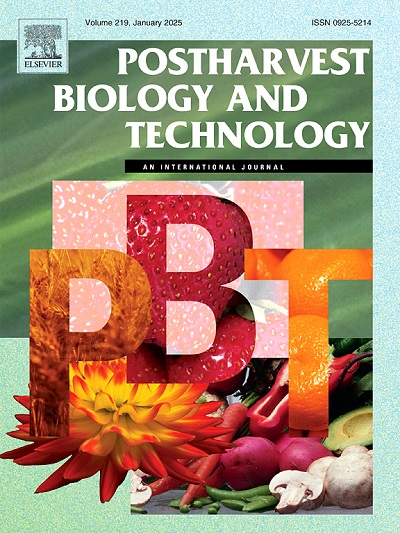通过x射线计算机断层扫描同时无损检测富士苹果的水核和瘀伤:双阈值分割和机器学习分类
IF 6.8
1区 农林科学
Q1 AGRONOMY
引用次数: 0
摘要
在中国和日本等市场,水核和瘀伤是决定优质富士苹果商业价值的决定性因素。本研究提出了一种非破坏性的方法,将x射线计算机断层扫描(CT)与图像处理和机器学习(ML)相结合,同时检测水核和瘀伤,并对水核的严重程度进行分级。基于阈值的分割方案(灰度值,水核为GSV > 437;瘀伤为GSV <; 0)实现了受影响组织的精确3D重建。提取了关键的形态学和统计学参数,其中volume3d、平均GSV和周长与水芯指数(WI)具有很强的相关性(R > 0.8, p <; 0.001)。lda、SVM和rf三种ML分类器对四级WI分类(正常,WI= 1-3)的验证准确率分别为82.87 %、91.20 %和90.28 %,得到了高auc (>0.9)的支持。SHAP分析证实了特征重要性(volume3d、A-GSV、周长)的跨模型一致性。至关重要的是,CT追踪了水岩芯在储存期间的缓解情况:在4°C下,9周后,水岩芯体积分数(WVF)从13.04 % (WI=1)、17.53 % (WI=2)和33.5 % (WI=3)下降到3.6-10.1 %。我们建立了诊断WVF阈值为11.2 %,并提出了存储协议:WI= 1立即销售,WI= 2存储≤ 6周,WI= 3消耗≤ 8周。该框架优化了感官质量、市场价值和供应链效率,为制定有针对性的分销策略提供了科学依据。本文章由计算机程序翻译,如有差异,请以英文原文为准。
Simultaneous non-destructive detection of watercore and bruising in ‘Fuji’ apples via X-Ray computed tomography: Dual-threshold segmentation and machine learning classification
In markets such as China and Japan, watercore and bruising are decisive factors determining the commercial value of premium-grade 'Fuji' apples. This study presents a non-destructive approach integrating X-ray computed tomography (CT) with image processing and machine learning (ML) to simultaneously detect watercore and bruising, and grade watercore severity. A threshold-based segmentation protocol (grayscale value, GSV > 437 for watercore; GSV < 0 for bruising) enabled precise 3D reconstruction of affected tissues. Key morphological and statistical parameters were extracted, with volume3d, average GSV, and perimeter exhibiting strong correlations to watercore index (WI) (R > 0.8, p < 0.001). Three ML classifiers—LDA, SVM, and RF—achieved validation accuracies of 82.87 %, 91.20 %, and 90.28 % for four-grade WI classification (Normal, WI=1–3), supported by high AUCs (>0.9). SHAP analysis confirmed cross-model consistency in feature importance (volume3d, A-GSV, perimeter). Crucially, CT tracked watercore remission during storage: watercore volume fraction (WVF) declined from 13.04 % (WI=1), 17.53 % (WI=2), and 33.5 % (WI=3) to 3.6–10.1 % after 9 weeks at 4°C. We established a diagnostic WVF threshold of 11.2 % and proposed storage protocols: WI= 1 for immediate sale, WI= 2 storage ≤ 6 weeks, WI= 3 consumption ≤ 8 weeks. The framework optimizes sensory quality, market value, and supply chain efficiency, providing a scientific basis for the development of targeted distribution strategies.
求助全文
通过发布文献求助,成功后即可免费获取论文全文。
去求助
来源期刊

Postharvest Biology and Technology
农林科学-农艺学
CiteScore
12.00
自引率
11.40%
发文量
309
审稿时长
38 days
期刊介绍:
The journal is devoted exclusively to the publication of original papers, review articles and frontiers articles on biological and technological postharvest research. This includes the areas of postharvest storage, treatments and underpinning mechanisms, quality evaluation, packaging, handling and distribution of fresh horticultural crops including fruit, vegetables, flowers and nuts, but excluding grains, seeds and forages.
Papers reporting novel insights from fundamental and interdisciplinary research will be particularly encouraged. These disciplines include systems biology, bioinformatics, entomology, plant physiology, plant pathology, (bio)chemistry, engineering, modelling, and technologies for nondestructive testing.
Manuscripts on fresh food crops that will be further processed after postharvest storage, or on food processes beyond refrigeration, packaging and minimal processing will not be considered.
 求助内容:
求助内容: 应助结果提醒方式:
应助结果提醒方式:


